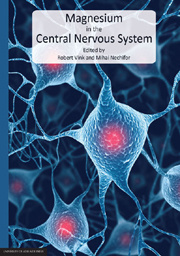Book contents
- Frontmatter
- List of Contributors
- Preface
- Contents
- Section 1 Magnesium in Normal Brain
- Section 2 Magnesium in Neurological Diseases
- Chapter 7 The role of magnesium therapy in learning and memory
- Chapter 8 The role of magnesium in headache and migraine
- Chapter 9 Magnesium in edema and blood-brain barrier disruption
- Chapter 10 Magnesium and hearing loss
- Chapter 11 The role of magnesium in pain
- Chapter 12 The role of magnesium in traumatic CNS injury
- Chapter 13 The use of magnesium in experimental cerebral ischaemia
- Chapter 14 Magnesium in subarachnoid hemorrhage
- Chapter 15 Magnesium in clinical stroke
- Chapter 16 Magnesium in cancer: more questions than answers
- Chapter 17 Magnesium in Parkinson's disease: an update in clinical and basic aspects
- Section 3 Involvement of Magnesium in Psychiatric Diseases
Chapter 12 - The role of magnesium in traumatic CNS injury
from Section 2 - Magnesium in Neurological Diseases
Published online by Cambridge University Press: 05 June 2012
- Frontmatter
- List of Contributors
- Preface
- Contents
- Section 1 Magnesium in Normal Brain
- Section 2 Magnesium in Neurological Diseases
- Chapter 7 The role of magnesium therapy in learning and memory
- Chapter 8 The role of magnesium in headache and migraine
- Chapter 9 Magnesium in edema and blood-brain barrier disruption
- Chapter 10 Magnesium and hearing loss
- Chapter 11 The role of magnesium in pain
- Chapter 12 The role of magnesium in traumatic CNS injury
- Chapter 13 The use of magnesium in experimental cerebral ischaemia
- Chapter 14 Magnesium in subarachnoid hemorrhage
- Chapter 15 Magnesium in clinical stroke
- Chapter 16 Magnesium in cancer: more questions than answers
- Chapter 17 Magnesium in Parkinson's disease: an update in clinical and basic aspects
- Section 3 Involvement of Magnesium in Psychiatric Diseases
Summary
Abstract
Traumatic injury to the central nervous system (CNS) is a leading cause of morbidity and mortality, and represents a significant public health issue. Despite intensive research, no effective neuroprotective therapy exists, and survivors of CNS injury, including traumatic brain injury (TBI) and spinal cord injury (SCI), can be left with severe disabilities that require long-term rehabilitation. Much of the damage that occurs after TBI and SCI develops over time with the primary injury initiating a secondary injury cascade made up of deleterious biochemical and pathophysiological reactions. This delayed development of secondary injury provides a vital opportunity for therapeutic intervention and considerable effort is currently being directed toward identifying these injury factors and developing interventions that may potentially prevent their actions. Magnesium (Mg2+) decline has been identified as playing a key role in the secondary injury process, in part because of its central role in the regulation of a large number of known injury factors and that its decline is associated with the development of motor and cognitive deficits. Mg2+ administration has been extensively investigated both preclinically in TBI and SCI and clinically as a neuroprotectant in TBI with varied success. This chapter focuses on the role of Mg2+ in TBI and SCI pathophysiology, with particular emphasis on Mg2+ as a potential therapeutic agent.
- Type
- Chapter
- Information
- Magnesium in the Central Nervous System , pp. 167 - 180Publisher: The University of Adelaide PressPrint publication year: 2011
- 5
- Cited by



